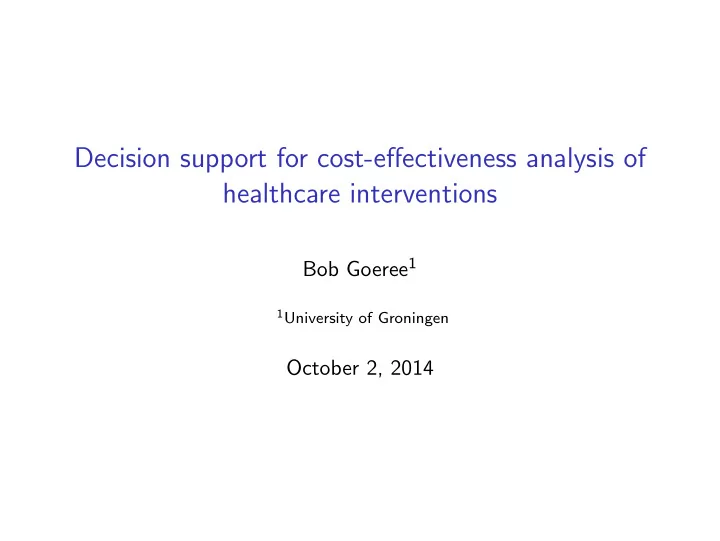

Decision support for cost-effectiveness analysis of healthcare interventions Bob Goeree 1 1 University of Groningen October 2, 2014
Outline Context Problems Cost-effectiveness analysis Live Demo Limitations Future work
New interventions Pharmaceutical Companies - Develop and manufacture medical interventions - Interventions are (very) expensive - New interventions have to be approved twice
Regulators 1/2 Pharmaceutical Drug Approval Companies Authorities - Assess potential benefits of a new intervention - Do the benefits outweigh the side-effects?
Regulators 2/2 Pharmaceutical Drug Approval Drug Reimbursement Companies Authorities Approval Authorities - Governments are faced with rising costs concerning health care - A second decision assess the benefits in relation to the cost of the new intervention
Usage Pharmaceutical Drug Approval Drug Reimbursement Drug Usage by Companies Authorities Approval Authorities Patients - When both decisions are met with a positive response
Evidence Pharmaceutical Drug Approval Drug Reimbursement Drug Usage by Companies Authorities Approval Authorities Patients Researchers Available Evidence - Both decisions are informed by high quality evidence - Evidence is published as scientific articles - A decision is informed by a consolidated view of the available evidence, meta analysis
Problems 1/2 - No repository containing structured data exists, evidence needs to be obtained manually. - An average time per review of 1110 person-hours (Allen and Olkin, 1999).
Problems 2/2 - Analysis are carried out using a series of disconnected tools - These tools are hard to use, even for experts - For every new intervention: A new analysis
ADDIS - Software that captures the entire workflow Pharmaceutical Drug Approval Drug Reimbursement Drug Usage by Companies Authorities Approval Authorities Patients 3. Support ADDIS Available Evidence 1. Aquisition of 2. Evidence synthesis evidence Researchers
Subject - Right now ADDIS supports the approval decision - But does not support the reimbursement decision How can ADDIS support decision makers concerned with the reimbursement of medical interventions?
Cost-effectiveness analysis 1/2 - The aproval decision is informed by an efficacy analysis - An efficacy analysis reports the data as-is - The reimbursement decision is informed by a cost-effectiveness analysis - A cost-effectiveness analysis extrapolates for future effects, through the use of a disease state model - A disease state model aims to approximate all effects and costs per patient, and offer a consolidated view of these outcomes
Cost-effectiveness analysis 2/2 - A patient can reside in a state, e.g. ’Alive’ or ’Dead’ - During simulation, a patient can travel to another state, modeled on either a discrete cycle of e.g. a year, or the time until a transition is measured, sojourn time - Based on the time a patient spends in a cycle, effects and costs are achieved - Costs and benefits are discounted for future effects - Results are reported in a consolidated view
Model - Let’s explain through a simplified model - Suppose we need to make the decision to allow the reimbursement of a diabetes intervention
Disease states No Diabetes Diabetes Dead
Transition Probabilities Suppose we obtained the following transition parameters for the no intervention on a yearly basis: - Patients who do not suffer from diabetes: 90 people do not develop diabetes, 7 people do develop diabetes and 3 people die - Patients who do suffer from diabetes: 90 people stay the same, 10 people die From clinial trials we obtain that the intervention has a positive effect on people that do not have diabetes, a 0.8 hazard ratio is reported.
Utility Weights Suppose we obtained the following effects with regards to diabetes: - Patients that do not have diabetes report a 0.84 effect on quality of life on a yearly basis - Patients that do have diabetes report a 0.65 effect on quality of life on a yearly basis
Costs Suppose we obtained the following Costs with regards to diabetes: - Diabetes treatment costs EUR 1805 on a yearly basis - The intervention costs EUR 300 on a yearly basis - Furthermore, patients that have been selected to receive the intervention have gone through a screening process, which costs EUR 400 - In accordance with zorginstituut (CvZ) guidelines we assume a yearly discount rate of 1.5% for effects and 4% for costs
Demo - At this point the analyst resorts to Excel/R/tool of choice to obtain results - While obtaining results can be complex, it always follows a general method - Instead of using those tools: current integration into ADDIS, live demonstration ( cea.drugis.org )
Limitations - Does not address patient heterogeneity - Only a select set of modeling choices available - All inputs are just numbers. Ideally inputs are derived, in an automated way, from the available (clinical) evidence - Mis match between the timescales of the efficacy analysis and the cost-effectiveness analysis
Future work - Better link with underlying data, its semantics and prerequisite statistical analysis - Modeling proposition based on obtained parameters - Integration between both decisions is anticipated (Bergmann et al., 2014)
Questions Thank you for your attention! Any questions?
Bibliography Allen, I. and Olkin, I. (1999). Estimating time to conduct a meta-analysis from number of citations retrieved. Journal of the American Medical Assosciation , 282(7):634–635. Bergmann, L., Enzmann, H., Broich, K., Hebborn, a., Marsoni, S., Goh, L., Smyth, J. F., and Zwierzina, H. (2014). Actual developments in European regulatory and health technology assessment of new cancer drugs: what does this mean for oncology in Europe? Annals of oncology : official journal of the European Society for Medical Oncology / ESMO , 25(2):303–6.
Recommend
More recommend